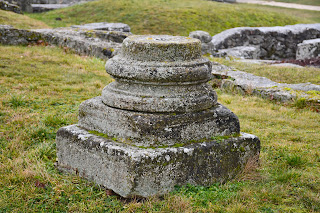From Bratislava to Vienna
The short stretch of the Danube between Bratislava and Vienna is perhaps one of the most historically significant parts of Central Europe. Littered with Roman settlements, medieval castles, and baroque palaces, it attracts hordes of tourists every summer, a fact discernible by the sheer number of hotels in unremarkable towns.
Departing from Bratislava in the morning,
we visited the Roman ruins of Carnuntum once more. Bursts of blue skies
succeeded moments of milky mists until around nine o’clock, when the weather
finally cleared up. We took the opportunity to revisit Hainburg and stopped by
the beautiful Parish Church of Bad Deutsch-Altenburg, built by Stephan I, the
first king of Hungary. From thence, we crossed the Danube and drove to Vienna,
making stops at Eckartsau Palace and Orth Castle.
Despite our short tour of Vienna in the
late hours of the afternoon, the main item on our agenda for the day was
visiting the Vienna State Opera for the traditional New Year’s Performance of
Strauss’s Fledermaus. My review of the event is mixed. Of course, the
venue is beautiful, and the intermissions are best spent walking around the
beautiful corridors and richly decorated parlors, with their marble statues and
intricate paintings in gilt frames. The opulence of the halls is reflected on
stage, where actors in historically accurate attire roam perfect replicas of
the finest Viennese houses and ballrooms.
Nevertheless, people who go to special
events like these use them to signify wealth and class rather than to deeply
appreciate music. Perhaps Johann Strauss II is not a composer known for
inventive melodies and rich instrumentalisation, but surely he deserves a
little better. His listeners that night were clearly not regular operagoers, some
talking loudly at inappropriate moments or tapping their feet to the rhythm until
the entire row shook. This laxity was, in turn, reflected on stage, where I
could not help feeling that good singing made too many compromises with
theatricality.
In any case, the evening was a cause for
reflection – not on the year but on the years that have passed. Fledermaus was
written as a celebration of a multi-national Austro-Hungarian empire, employing
the German waltz, the Hungarian csardas, and the Czech polka. Even the
Slivovitz so often mentioned in the Third Act is symbolic of the multi-national
union: people tend to associate it with the southern Slavs. All this, and the
realities of life so familiar to audiences that once watched this opera in the
very same building, have been washed away. Russian princes have been shot in the
head and replaced by oligarchs, while English cultural references have largely overwhelmed
the Germanic cultural milieu of Central Europe.
At the same time, there were moments when I genuinely felt like a visitor at a nineteenth-century World’s Fair. Clearly apprised of the formality of the event, sitting in front of us was an elderly Japanese couple dressed in what appeared to be very expensive festive kimonos. On their right were two Americans in suits and ties, with sleek dark hair, one of them making expressive grimaces and gesticulations like an outdated caricature of a wall-street businessman.








































Comments
Post a Comment